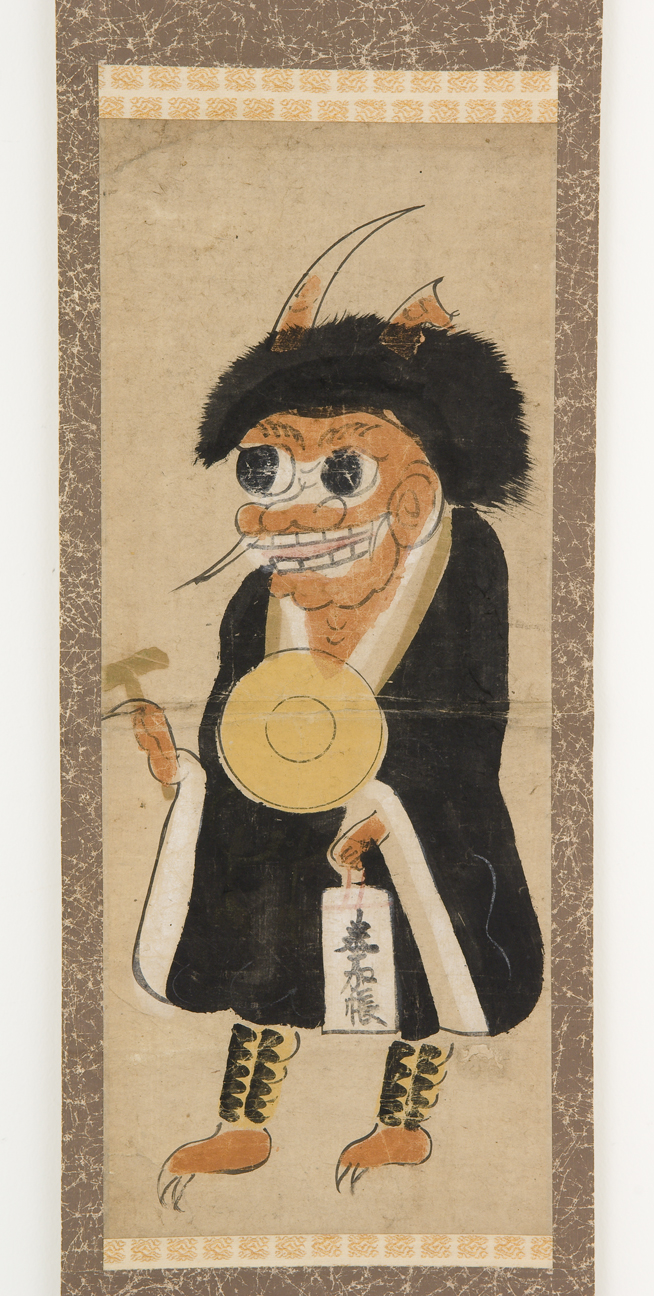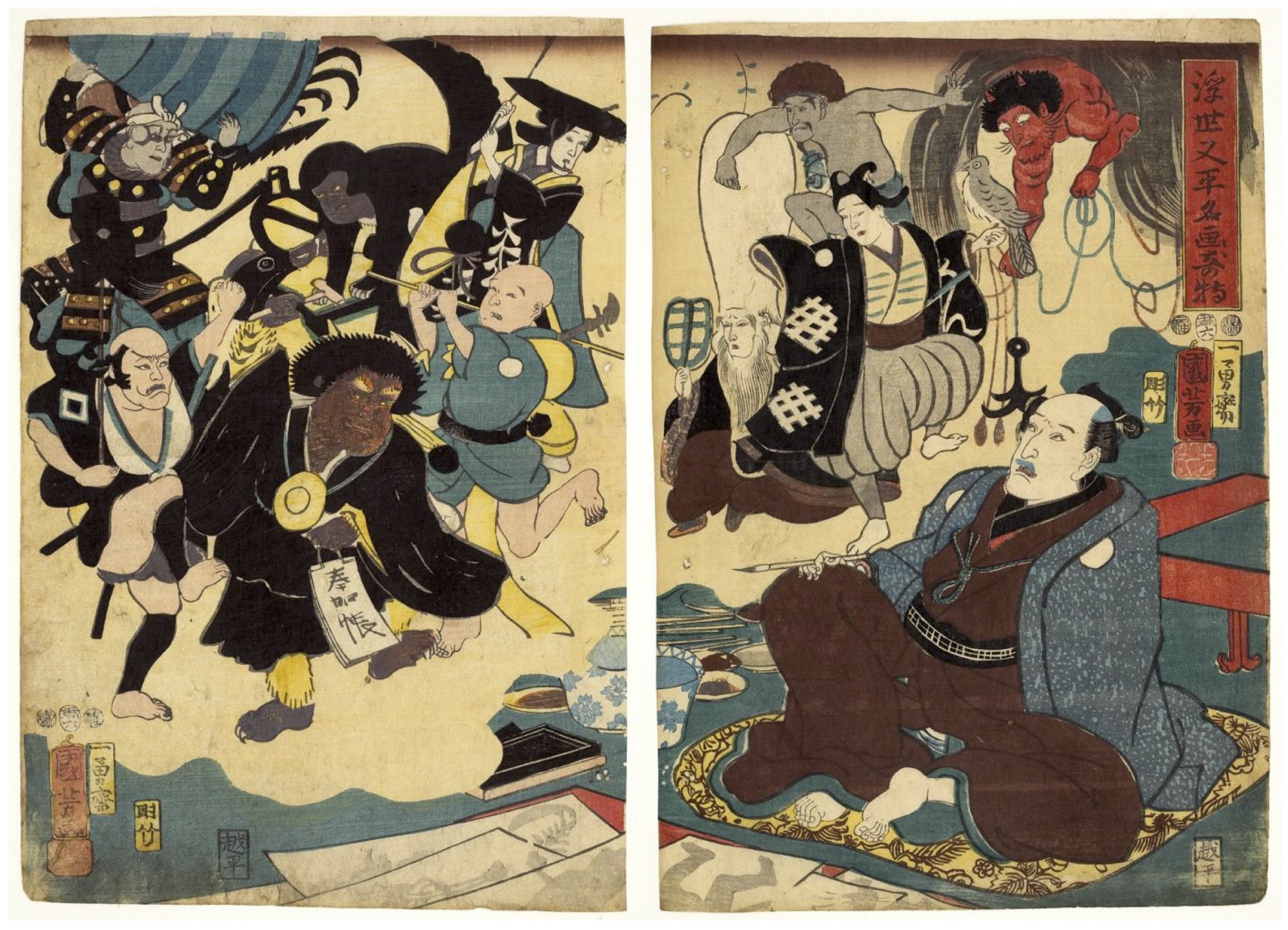The Art Historical Precedents of Manga, Part 3 of 5: Ōtsu-e
For Part 1 of this series exploring the art historical origins of manga, click here. For Part 2, click here.
In recent blog posts, I have presented several pre-modern and early modern trends in Japanese art as indirect contributions to the aesthetics of modern and contemporary Japanese comics. To that list, I would like to add the genre of folk painting produced from the early 17th century until the late 19th century in Ōtsu City, Ōmi Province (modern-day Shiga Prefecture). Known as Ōtsu-e (literally, “pictures from Ōtsu”), these works were originally intended as Buddhist devotional images and were produced by anonymous artists in a highly gestural fashion. Gradually, the pictorial themes expanded to include secular topics from classical literature and other sources. Popular characters include a demon in the guise of a Buddhist monk chanting the name of the Amitābha Buddha (Oni nenbutsu), a woman holding a wisteria branch (Fuji musume), and a blind musician fending off a dog with his crutch (Zatō to inu). As a port on Lake Biwa and a station along the Tōkaidō Road that connected Edo and Kyoto, Ōtsu experienced a considerable amount of foot traffic, and these artworks were intended as inexpensive souvenirs for visitors and passersby.

Demon as Buddhist monk
Anonymous. Demon Chanting Buddha’s Name. Japan, Edo period (1615–1868), 18th or early 19th century. Hanging scroll; ink and color on paper. Gift of Mrs. Theodore A. Cooke, 1958 (2542.1)
Ōtsu-e was popularized to a surprising extent during the Edo period (1615–1868) through theater and music. In 1708, the celebrated playwright Chikamatsu Monzaemon (1653–1725) wrote a libretto for the Jōrūri puppet stage that describes an Ōtsu-e artist whose painted characters come to life. The play enjoyed such popularity that it inadvertently led to the widespread, erroneous belief that the historical artist Iwasa Matabei (1578–1650), upon whom the protagonist was based, was the originator of both Ōtsu-e and ukiyo-e. Other forms of performance art, including the well-known Kabuki dance “Wisteria Maiden” (“Fuji musume,” 1826), and the late-Edo folk song “Ōtsu-e bushi,” drew further public attention to the appeal of Ōtsu-e.
Riding upon the coattails of these tremendously popular performances, a number of woodblock print designers, including Utagawa Kuniyoshi (1798–1861), produced prints based directly upon Ōtsu-e imagery. In Kuniyoshi’s diptych Miracle of Masterpieces by Floating-world Matabei (Ukiyo Matabei meiga no kitoku, 1853), the painter Iwasa Matabei sits on the floor of his studio, his sketches scattered in front of him. Within a yellow cloud that fills the remainder of the composition, the pantheon of Ōtsu-e characters, led by a demon in Buddhist robes, parade towards him. Matabei leans backwards, astonished that he has inadvertently conjured these beings. Kuniyoshi himself was probably likewise surprised by the degree of controversy that his print caused. Despite being originally approved by censors, it was quickly interpreted by the public as possessing subversive political meaning. In reaction, the Edo City magistrate immediately banned the print, fired the censors who approved the design, and ordered the destruction of the woodblocks used for that print.

Kuniyoshi
Utagawa Kuniyoshi (1798–1861). Miracle of Masterpieces by Floating-world Matabei. Japan, Edo period (1615–1868), 1853. Woodblock print; ink and color on paper. Gift of Mr. Victor S.K. Houston, in honor of his wife, Pinao Brickwood Houston, 1942 (11642.66–67)
Whether for its own charming imagery or for its connection to ukiyo-e prints such as Kuniyoshi’s, Ōtsu-e eventually experienced a resurgence of popularity in the early 20th century, and today, it is sold not by anonymous street venders but by well-established art galleries. Likewise, the sensibility of Ōtsu-e can be felt in modern Japanese cartoons, and in that form, has expanded far beyond the borders of Ōtsu City.
– Stephen Salel, Curator of Japanese Art